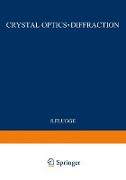Kristalloptik · Beugung / Crystal Optics · Diffraction
BücherAngebote / Angebote:
139 long ago that, when an extended source of unpolarised light is viewed through a highly dichroic crystalline plate cut normal to one of the optic axes, two dark brushes-the BREWSTER'S brushes-are seen. In the interference between crossed polaroids the dark isogyres do not in general pass through the optic axial directions as they do in the case of transparent crystals. These phenomena can be broadly explained using the approximate theory mentioned in Sect. 43 where the waves propagated along any direction are taken to be linearly polarised. We have seen however that according to the rigorous theory the two waves are really elliptically polarised with non-orthogonal states. Corresponding to this we meet with phenomena which have no parallel whatsoever in the case of trans parent crystals. Thus, if the incident light is polarised, then even without an analyser behind the plate, feeble interference phenomena-the idiophanic rings are seen. These arise because the two beams into which the incident light is decomposed along any direction can directly interfere with one another as they are not orthogonally polarised. More striking is the fact that, with an analyser behind the plate, idiophanic interference rings appear even with the incident light completely unpolarised. The explanation of this phenomenon leads us to the concept of the partial coherence between the component non-orthogonal beams into which the incident unpolarised light is split.
Folgt in ca. 5 Arbeitstagen



